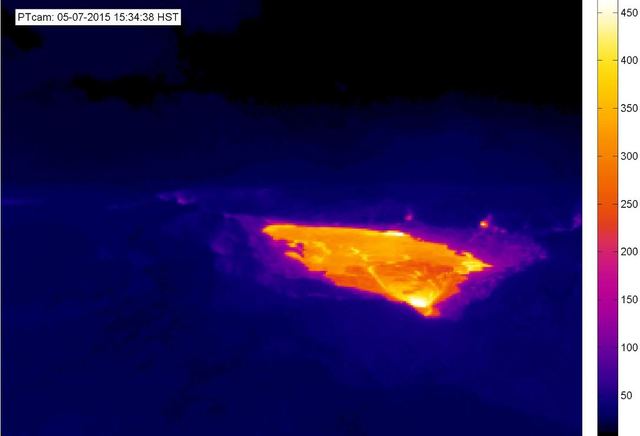Volcano Watch: Volcano alarms — keeping HVO virtually vigilant 24/7

Ping!
ADVERTISING
It’s 2:12 a.m., and I (a USGS Hawaiian Volcano Observatory scientist) am still groggy as I read an automated text from HVO’s computer system. A series of earthquakes just occurred at Kilauea’s summit, but I can tell it’s routine activity and not a ramp-up toward an eruption. HVO’s seismologist also will have been alerted, and I’m confident he’ll call if it’s something serious.
So, it’s back to sleep.
Volcanoes don’t keep time as we humans do. “Regular” work hours and our need for sleep don’t figure into when they begin to rock and roll.
Despite dedicated staff at HVO and overnight checks by colleagues at the USGS National Earthquake Information Center in Golden, Colo., there are times when no human actually is watching the flood of data streaming in from multiple seismometers, GPS receivers, tiltmeters, web cameras and other monitoring instruments scattered strategically across Hawaii’s volcanoes. Nevertheless, the volcanoes still are monitored around the clock. How is this possible? In a word, alarms. For volcanoes that are quiet most of the time, alarms are an efficient way to use limited human resources.
Alarms have been around for decades, but automated phone calls, pages and ringing bells have been replaced by texts and emails. Think of it as a digital tap on the shoulder from a never-sleeping computer algorithm. When that “tap” happens, the HVO scientist on duty immediately and carefully examines the data and decides if further action is needed.
For example, HVO’s Swarm Alarm counts earthquakes occurring in a certain region of the volcano — say, Kilauea’s summit area — within the past hour. The system automatically notifies our monitoring group if the number surpasses the threshold set by HVO’s seismologist. This is because an unusual cluster of earthquakes could signal a change in the volcanic system that might lead to a new outbreak of lava.
Another alarm system monitors the slope of the ground using electronic tiltmeters. Slow changes in tilt are not unusual as the volcano adjusts in response to magma shifts within shallow reservoirs. However, if more rapid changes are detected, a computer program sends texts to notify us it’s time to take a closer look at what else is happening.
HVO deploys thermal cameras that look into the Pu‘u ‘O‘o crater. These cameras take fresh pictures every two minutes, and, if a hot spot fills more than 5 percent of the images, sends us a text message with an embedded image. Upon receiving such a message, we check other data (including more recent webcam images) to see if lava is filling or overflowing the crater.
HVO also uses Geostationary Operational Environmental Satellite (GOES) thermal imagery to look for elevated ground temperatures in areas other than at Kilauea’s summit and on the Pu‘u ‘O‘o lava flow field. If elevated temperatures are found, a computer program sends a text message with an embedded image to HVO geologists so the situation can be further investigated.
Alarms have long been used at HVO, but they have certainly evolved from their low-tech origins. During the early episodes of Kilauea’s ongoing East Rift Zone eruption, HVO scientists wanted to know exactly when lava began spilling out of the Pu‘u ‘O‘o crater, which usually indicated the onset of lava fountains. This was in 1983, years before the advent of webcams. So, HVO staff had to lug a heavy and ungainly spool of copper cable over rugged lava flows and across the spillway, where lava would first flow down the side of Pu‘u ‘O‘o. Using this cable, a steady voltage was radioed back to HVO, and when readings from this electronic tripwire suddenly were interrupted, we knew lava broke the circuit.
We now have far more sophisticated ways to trigger alarms when the status of Hawaii’s active volcanoes changes. As instrumentation and computer technology advance, even better techniques for triggering and evaluating volcano alarms no doubt will evolve.
In addition, we will continue to fine tune algorithms specifically for each volcano and each type of data stream to minimize false alarms. Perhaps someday, an expert program will synthesize all the different datasets to present a preliminary interpretation. Until then, human intervention is essential to evaluate and validate the information. Even in the middle of the night. Ping!
Kilauea activity update
Kilauea’s summit lava lake level fluctuated in response to summit inflation and deflation during the past week, with measurements ranging between 51 m (167 ft) and 41 m (135 ft) below the vent rim.
Kilauea’s East Rift Zone lava flow continues to feed widespread breakouts northeast of Pu‘u ‘O‘o. Active flows slowly are covering and widening the flow field, but remain within about 8 km (5 mi) of Pu‘u ‘O‘O.
There were no earthquakes reported felt on the Island of Hawaii during the past week.
Visit the HVO website (http://hvo.wr.usgs.gov) for past Volcano Watch articles, Kilauea daily eruption updates and other volcano status reports, current volcano photos, recent earthquakes, and more; call 808-967-8862 for a Kilauea summary update; email questions to askHVO@usgs.gov.
Volcano Watch (http://hvo.wr.usgs.gov/volcanowatch/) is a weekly article and activity update written by scientists at the U.S. Geological Survey`s Hawaiian Volcano Observatory.


